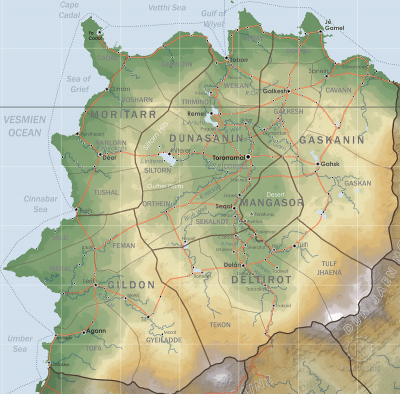Taslamac
Taslamac [tass-LAM-ack], colloquially called the Red City, is a city in in southern Ororr, on the north bank of the Red Wiyel. It is in the Mangasor Special Autonomous Region, benefiting from relatively low regional taxes and regulation.
Ororrplugin-autotooltip__small plugin-autotooltip_bigOrorr (Category)
Articles related to the Anasthian nation of Ororr.
[Ororr]
Regions
Provinces
Cities
Beliefs
People
Ethnic groups
topics nati1
This is in a series of articles on the modern nation-station of Ororrplugin-autotooltip__small plugin-autotooltip_bigOrorr
Ororr [o-ROARR, ɒ̝rɔ'ɾ], also called the Holy Motherland of Ororr, is a theocratic nation in Anásthias, one of the world's great powers. It the largest nation in the world, perhaps the largest empire in history, occupying the entire northwest of the continent between the mountains and the sea. Ororrlanguagelanguagelanguage.

Hover to magnify | Go to world mapplugin-autotooltip__small plugin-autotooltip_bigAtlas: Ororr
[fmap-ororr.png] * Zoom out * Gildon * Moritarr * Deltirot * Dunasanin * Gaskanin * Mangasor * @ * @
Political | Geography
atlas nationmaps
Ororr
Ororr [o-ROARR, ɒ̝rɔ'ɾ], also called the Holy Motherland of Ororr, is a theocratic nation in Anásthias, one of the world's great powers. It the largest nation in the world, perhaps the largest empire in history, occupying the entire northwest of the continent between the mountains and the sea. languagelanguagel…
- Name: Holy Motherland of Ororr
- Government: Theocratic Republic
- Capital: Torroramaiplugin-autotooltip__small plugin-autotooltip_bigTorroramâi
Torroramâi (also Tororr, T'amai, [tɔ-ROR-ah-MAH-ee, or simply “The Capital”) is the administrative and religious capital of the modern nation-state of Ororr.
Torroramai
This is in a series of articles about Torroramai, capital city of the nation of Ororr.viridviridOrorrOrorrviridviridgreenvirid - Foundation: 52 MEplugin-autotooltip__small plugin-autotooltip_bigME
ME is short for Modern Epoch, the modern method of numbering years. (Official) - Demonym: Ororran
- Language: Dorounplugin-autotooltip__small plugin-autotooltip_bigDoroun language
Doroun [doh-ROON, dɒ'ruːn] is the common language of Ororr, the principle language of law, trade, government and the Mother Church.
Language
language
This is in a series of articles about Languages and Communication.
Doroun is spoken as a first language in the regions of Dunasanin and Gaskanin, and as a second language in other regions. It developed from the languagelanguagelanguageOrorrlanguagelanguagelanguagelanguagelanguagelanguagelanguagelanguagelanguagelanguagelanguage… (official), regional languages - Religion: Mother Church of Ororr (Therism)plugin-autotooltip__small plugin-autotooltip_bigMother Church of Ororr (Therism)
The Mother Church is the state religion of Ororr, which combines both religion and government in one institution. It is based on the teachings of the Great Prophet Therion, who in the early decades of the modern era raised an army that conquered much of northwestern OrorrOrorrOrorrOrorrOrorrMEMEOrorrMEMEOrorrOrorrHerHerHerHerHerHerHerHerHerher
Geography
The city is mainly built of red mud brick and tiles, its streets drifting with red dust, hence it being called the Red City. In richer neighbourhoods, watermen sprinkle water onto the streets to keep down the omnipresent dust. In ancient times it was laid out as a grid, similar to ancient Issid style. Today its architecture is very different, its houses being long and narrow, usually of only one or two storeys. The city is still surrounded by its red brick walls, but their soft construction and low rise is mainly to control the flow of goods, people and animals rather than practical defensive purposes.
The local stone and clay soil is rich with iron, so the city has long been a source of iron ore. Historically it was source of the rare red jade prized by many cultures of the River Wiyel, but the nearby jade pits were mined out long ago. Today the chief industries are pig iron and tiles, baked from the red river clay. Chiefly the city prospers on trade, both by river and overland via the caravan road to Sineratot, 170 km to the southeast.
History
Taslamac was historically an independent kingdom, devoted to its red crocodon god. The city had a long-standing rivalry with the Kingdom of Seqal, fighting many battles and trade wars. It remained independent well into the time of the Empire of Dor-en-Sann, entering the empire through negotiation.
During the early organisation of the new nation of Ororr, Taslamac was set to become part of Tulf Jhaena province, a part of Deltirot, which citizens considered unacceptable. The tile-makers of the city offered to create a dazzling array of tiles in the construction of the Prophet's shrine of Foratuna, and in thanks, the Mesekk, the chief priesthood of Foratuna, requested that Taslamac be incorporated into the Mangasor region.
